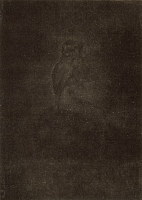Etchings Institutions search term: hunterian art gallery
The Model | ||
| Number: | 248 | |
| Date: | 1883/1885 | |
| Medium: | mezzotint | |
| Size: | 253 x 178 mm | |
| Signed: | no | |
| Inscribed: | no | |
| Set/Publication: | no | |
| No. of States: | 1 | |
| Known impressions: | 4 | |
| Catalogues: | K.346; M.344 | |
| Impressions taken from this plate (4) | ||
 ), and which was bought by Charles Lang Freer (1856-1919) in May 1893.
), and which was bought by Charles Lang Freer (1856-1919) in May 1893.1: [1884/1886], GUW #08105; Hopkinson 1998 .
It is more likely that Whistler had plans to make mezzotint reproductions after his oil portraits, such as Arrangement in Grey and Black: Portrait of the Painter's Mother [y101]. A squared grid - 'the little frame and board with wires' - would have been required to ensure accuracy. In the event Whistler did not make any such copies, but a few years later Richard Josey (1840-1906) made mezzotints, 'UNDER THE IMMEDIATE SUPERVISION OF THE PAINTER', after Arrangement in Grey and Black: Portrait of the Painter's Mother [y101], Arrangement in Grey and Black, No. 2: Portrait of Thomas Carlyle [y137] and Arrangement in Brown and Black: Portrait of Miss Rosa Corder [y203]. These were published by Graves & Co. in 1879-1880. 3
2: Whistler to W. C. Alexander, 1 February 1875, GUW #07565; Hopkinson 1998 , p. 400.
3: Subscription form, 3 July 1878, GUW #13913.
4: Hopkinson 1998 , p. 400.
